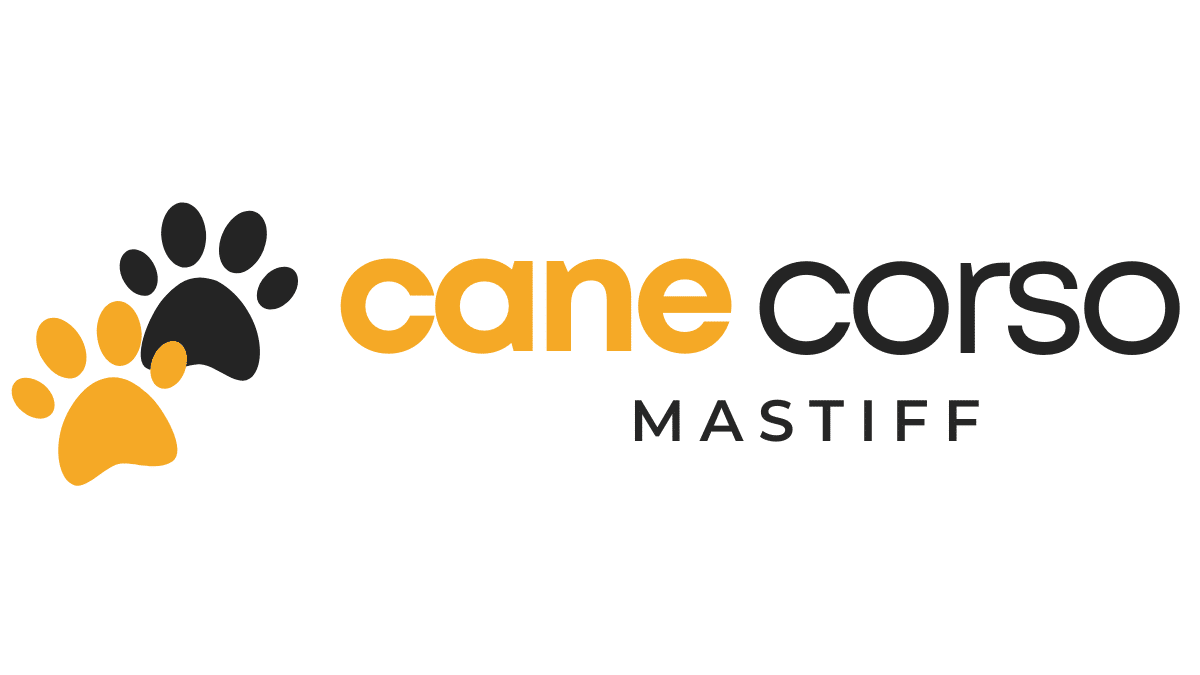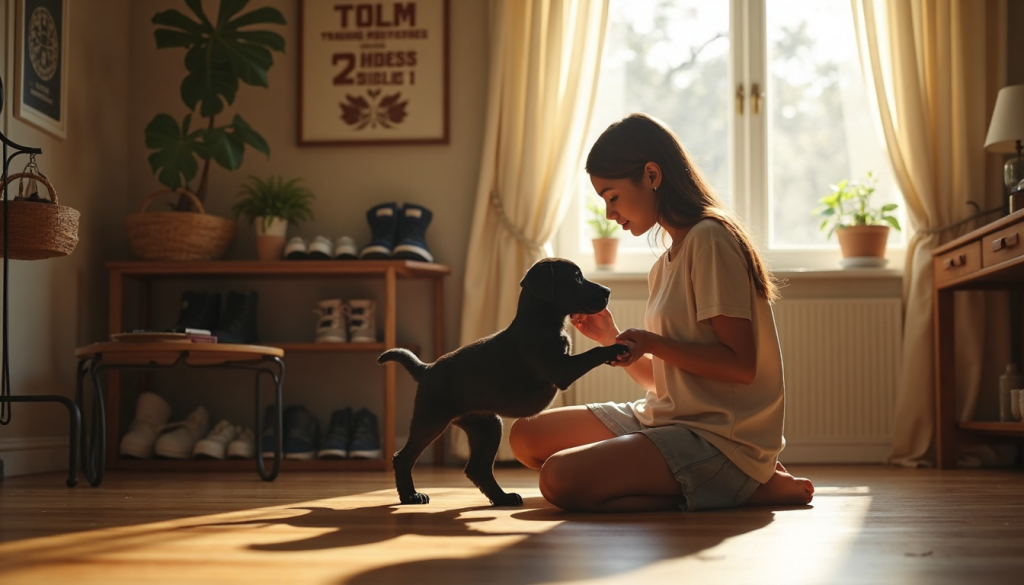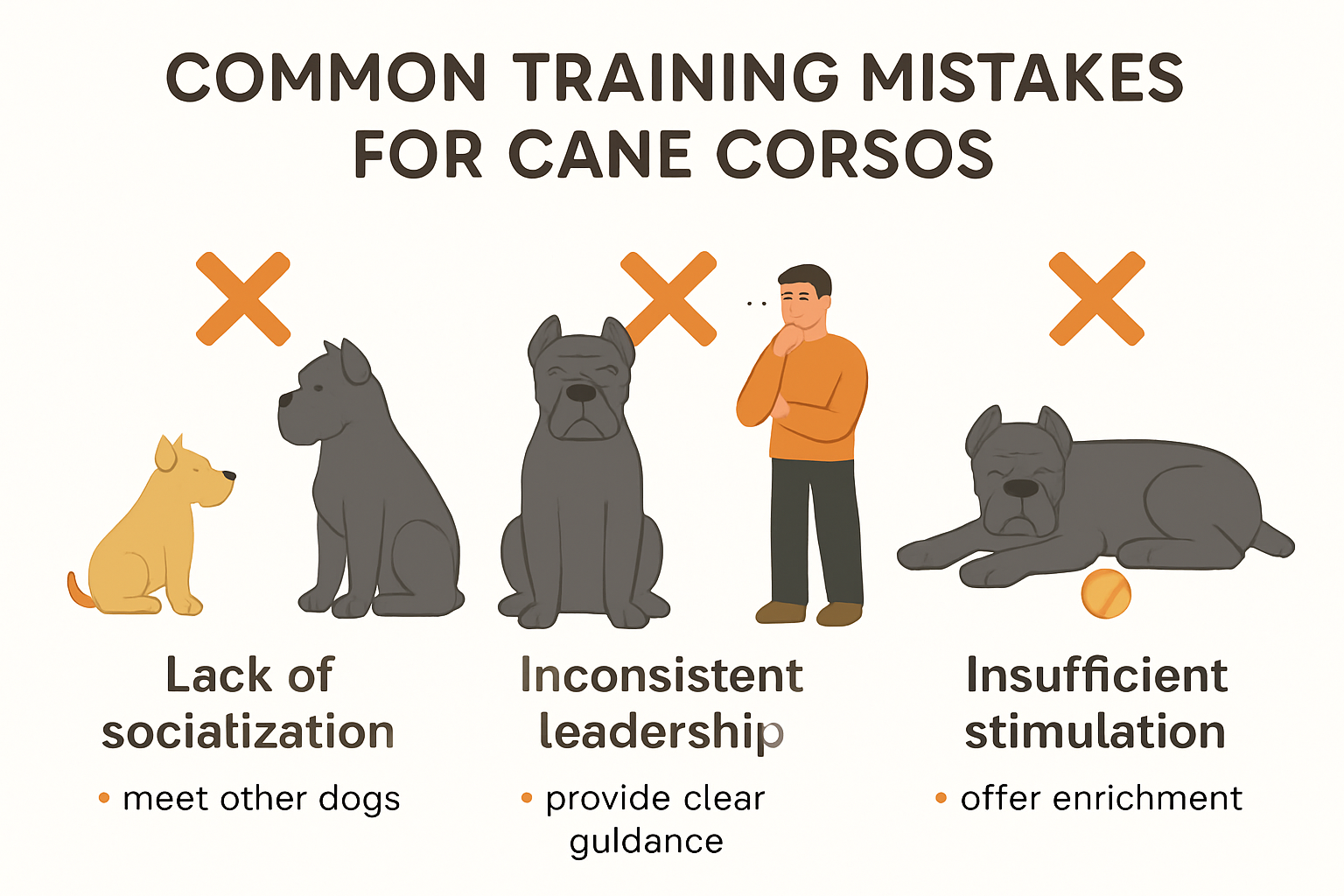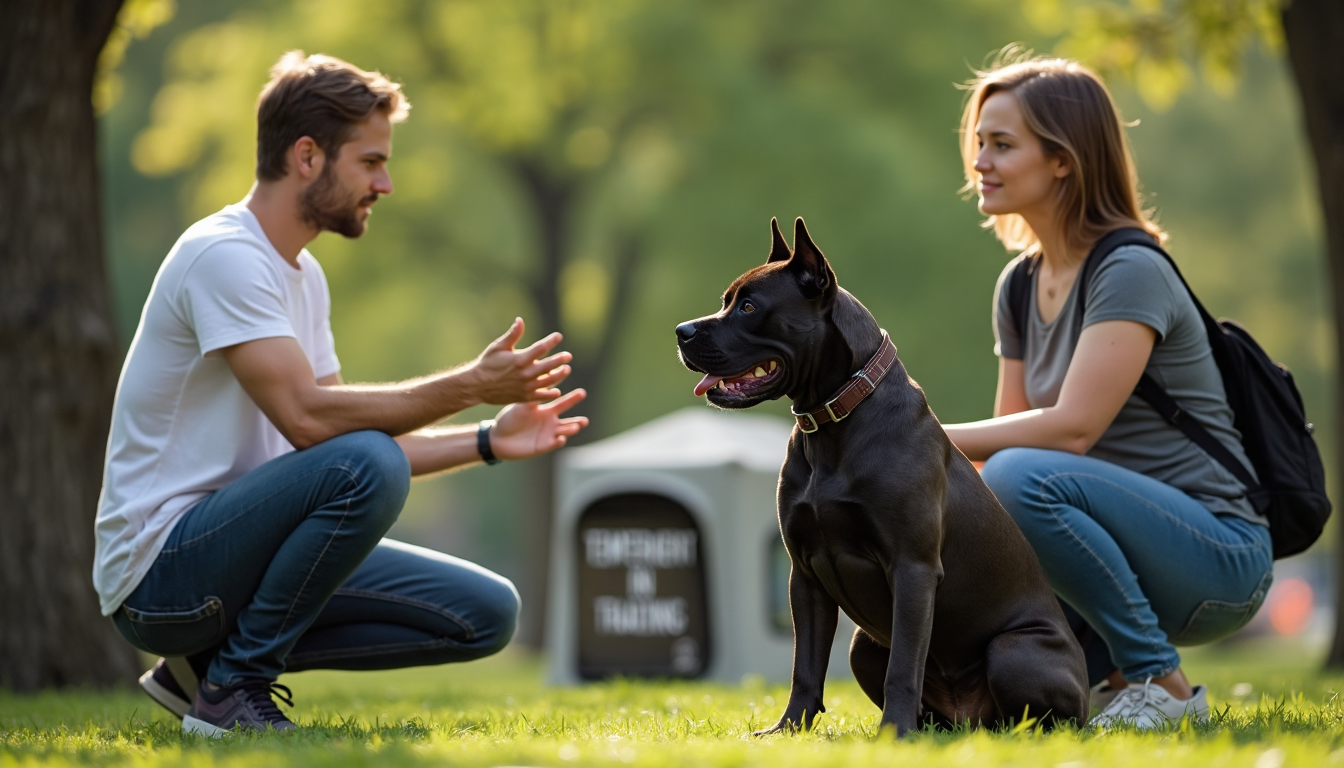Cane Corsos are commanding dogs with a reputation for loyalty and strength, but those massive muscles can quickly turn into mayhem without the right approach. Here is something most owners miss. Neglecting early socialization during the critical 3 to 16 week window can lead to lifelong fear and aggression issues. The biggest risk is not from the dog’s size or energy, but from tiny training slips that can quietly shape a stubborn or unpredictable adult. Want a calm and confident companion instead of a handful? It all starts with the way you handle the first steps.
Table of Contents
- Biggest Training Mistakes With Cane Corsos
- Understanding Cane Corso Temperament In Training
- How To Fix Common Cane Corso Training Errors
- Building Better Habits: Positive Methods For Cane Corsos
Quick Summary
| Takeaway | Explanation |
|---|---|
| Neglecting Early Socialization | Failing to socialize a Cane Corso during the critical period of 3 to 16 weeks can lead to fear, aggression, and difficulty adapting to new situations. Owners should ensure positive exposure to various people, animals, and environments during this time. |
| Inconsistent Training and Leadership | Clear and consistent leadership is essential for Cane Corsos to prevent behavioral issues. All family members must use the same commands and reinforcement techniques to avoid confusion and ensure the dog understands its place in the hierarchy. |
| Insufficient Physical and Mental Stimulation | Cane Corsos require adequate exercise and mental challenges to prevent destructive behaviors. Daily walks should be complemented with training exercises, dog sports, and puzzle toys to engage their intellect and energy. |
| Positive Reinforcement as a Key Method | Utilizing positive reinforcement—rewarding desired behaviors—creates a trusting and cooperative training environment. This approach makes training enjoyable and fosters a strong bond between the dog and owner. |
| Addressing Behavioral Patterns | To correct negative behaviors, owners should use a strategy of positive reinforcement while ignoring unwanted actions. Immediate rewards for calm behavior teach the dog that good actions lead to positive outcomes. |
Biggest Training Mistakes with Cane Corsos
Training a Cane Corso requires precision, patience, and a deep understanding of the breed’s unique characteristics. Many owners inadvertently make critical errors that can compromise their dog’s development and potential. Learn how to avoid common training pitfalls with our comprehensive guide on Cane Corso training challenges.
Neglecting Early Socialization
The most fundamental training mistake with Cane Corsos is overlooking early socialization. According to research from enviroliteracy.org, the critical period between 3 to 16 weeks is crucial for developing a well-adjusted dog. Owners who fail to expose their Cane Corso to diverse people, animals, and environments during this window risk creating a dog prone to fear, aggression, or excessive protectiveness.
Socialization is not just about exposure. It requires structured, positive interactions that build confidence and teach appropriate responses. This means carefully introducing your Cane Corso to different sounds, textures, people of various ages, and other animals in controlled, safe environments. Without this foundation, you may end up with a dog that struggles to adapt to new situations and becomes reactive or defensive.
Inconsistent Training and Leadership
Cane Corsos are powerful dogs with strong personalities that demand clear, consistent leadership. Inconsistent training methods can quickly undermine your authority and lead to behavioral challenges. As expert sources highlight, these dogs require firm but patient guidance to prevent dominance-related issues.
This means establishing clear rules and boundaries from day one. Every family member must follow the same training approach, using identical commands and reinforcement techniques. Vacillating between strict discipline and permissive behavior creates confusion and can result in a dog that tests limits constantly. Your Cane Corso needs to understand their place in the family hierarchy without feeling oppressed.
Insufficient Physical and Mental Stimulation
Underestimating the breed’s exercise and mental stimulation needs is a critical training mistake. Research indicates that without adequate physical and cognitive engagement, Cane Corsos can develop destructive behaviors such as excessive digging, barking, and potential aggression.
These dogs are not just physically imposing but intellectually complex. They require a combination of structured exercise and challenging mental activities. This means more than just daily walks. Incorporate training exercises that challenge their problem-solving skills, engage them in dog sports, and provide puzzle toys that keep their mind active. A bored Cane Corso is a potential behavioral time bomb.
Training a Cane Corso is a commitment that demands understanding, consistency, and respect for the breed’s inherent traits. By avoiding these common mistakes, you can develop a well-adjusted, obedient, and confident companion that reflects the true potential of this magnificent breed.
To clarify the key training mistakes commonly made with Cane Corsos, the following table summarizes the mistake, the associated risk, and the recommended solution as discussed above.
| Mistake | Risk/Consequence | Recommended Solution |
|---|---|---|
| Neglecting Early Socialization | Fear, aggression, lack of adaptability | Structured, positive exposure to people, animals, environments (3-16 wks) |
| Inconsistent Training and Leadership | Confusion, dominance issues, boundary testing | Establish and maintain uniform rules, commands, and leadership |
| Insufficient Stimulation | Destructive behaviors, excessive barking, potential aggression | Adequate daily exercise, mental challenges, training, and play |
Understanding Cane Corso Temperament in Training
Training a Cane Corso demands more than standard obedience techniques. These powerful dogs possess a complex temperament that requires nuanced understanding and strategic approach. Learn more about the intricate personality traits of this remarkable breed.
Genetic Predispositions and Behavioral Foundations
Cane Corsos are descended from ancient Italian working dogs with strong guardian instincts. According to the American Kennel Club, their genetic background significantly influences their training requirements. These dogs are naturally protective, intelligent, and possess an inherent desire to work closely with their human companions.
Their temperament is characterized by a unique blend of confidence and sensitivity. While they appear stoic and powerful, Cane Corsos are remarkably attuned to their owner’s emotions and energy. This sensitivity means training must balance firmness with emotional intelligence. Harsh corrections can damage their trust, while overly permissive methods will fail to establish necessary boundaries.
Leadership and Psychological Dynamics
Dominant yet responsive describes the core psychological profile of a Cane Corso. Expert research from thecynologist.com emphasizes that these dogs require consistent, confident leadership. They are not submissive by nature but are deeply loyal and eager to understand their role within the family hierarchy.
Successful training hinges on establishing yourself as a calm, assertive leader. This means providing clear communication, setting predictable rules, and maintaining emotional equilibrium during training sessions. Cane Corsos respect structure and will naturally align with an owner who demonstrates steady, reliable guidance. Inconsistent leadership can lead to behavioral challenges, as these intelligent dogs will quickly identify and exploit any weakness in command structure.
Emotional Intelligence and Training Approach
Training a Cane Corso is a psychological dance that requires understanding their emotional landscape. Research from acanecorso.com highlights the importance of mental stimulation alongside physical exercise. These dogs are not just physically robust but intellectually complex.
Positive reinforcement works best with this breed. They respond exceptionally well to reward-based training that makes them feel engaged and appreciated. Punishment-based methods will likely result in resistance or shutdown. Each training session should feel like a collaborative effort where the dog feels challenged but supported. Incorporate variety in training exercises to keep their keen minds stimulated and prevent boredom.
Ultimately, understanding a Cane Corso’s temperament is about recognizing their dual nature: powerful guardians with deeply sensitive souls. Successful training transforms these magnificent dogs from mere pets into true partners, capable of extraordinary loyalty and performance.
How to Fix Common Cane Corso Training Errors
Cane Corso training requires strategic intervention and precise correction techniques. Addressing training errors effectively can transform challenging behaviors and strengthen the bond between owner and dog. Discover advanced strategies for overcoming training challenges.
Addressing Leadership and Consistency Issues
Inconsistent leadership represents a critical training error that can derail your Cane Corso’s development. According to research from fursnpaws.com, these intelligent dogs quickly recognize and exploit inconsistencies in training approach. Establishing clear, uniform rules across all family members becomes paramount.
To remedy leadership challenges, implement a structured training protocol where every family member follows identical commands and correction methods. This means agreeing on specific verbal cues, hand signals, and reward systems. Create a comprehensive training manual that outlines expectations, ensuring everyone interacts with the dog using the same consistent approach. Unified leadership prevents confusion and helps your Cane Corso understand boundaries more effectively.
Correcting Behavioral Reinforcement Patterns
Many owners unintentionally reinforce negative behaviors without realizing it. Expert sources from fursnpaws.com highlight that giving attention during unwanted actions can inadvertently teach a Cane Corso that problematic behaviors generate desired responses.
To break these patterns, implement a strategic approach of positive reinforcement and deliberate ignore techniques. When your dog displays undesirable behavior like excessive barking or jumping, completely withdraw attention. Do not make eye contact, speak, or touch the dog. Simultaneously, immediately reward calm, appropriate behaviors with treats, praise, and engagement. This method teaches the dog that calm, controlled actions generate positive outcomes.
Systematic Retraining and Behavior Modification
Retraining a Cane Corso requires patience, consistency, and a methodical approach. Behavioral experts recommend breaking complex behavioral issues into manageable, trainable components. Start by identifying specific problematic behaviors and designing targeted intervention strategies.
For instance, if leash pulling is an issue, begin with short training sessions in low-distraction environments. Use high-value treats and immediate positive reinforcement when the dog walks calmly beside you. Gradually increase difficulty by introducing more distractions and challenging environments. Each successful interaction builds confidence and reinforces desired behavior.
Remember that fixing training errors is not about punishment but about creating a clear, positive communication system with your Cane Corso. These dogs are intelligent and eager to please when given proper guidance. Approach each training challenge as an opportunity to strengthen your relationship and develop a deeper understanding of your remarkable companion.
To make the process of fixing common Cane Corso training errors more actionable, here’s a step-by-step table outlining the corrective approach described above.
| Step | Action | Purpose |
|---|---|---|
| 1. Identify Issue | Pinpoint specific undesired behavior (e.g., leash pulling, barking) | Focus correction efforts for effectiveness |
| 2. Analyze Reinforcement | Determine if negative behaviors are unintentionally rewarded | Stop reinforcing unwanted behavior |
| 3. Implement Consistency | Align training cues, rules, and rewards with all family members | Provide clear expectations and reduce confusion |
| 4. Use Positive Methods | Reward desired behaviors promptly; ignore/pause attention for negatives | Reinforce positive habits; extinguish negative behaviors |
| 5. Gradual Challenge | Progressively increase difficulty (distractions, duration, context) | Build reliability and adaptability in the dog’s responses |
Building Better Habits: Positive Methods for Cane Corsos
Positive reinforcement training represents the most effective approach for developing exceptional behavior in Cane Corsos. These intelligent dogs respond remarkably well to methods that build trust, encourage cooperation, and create meaningful communication. Explore advanced positive training techniques for your Cane Corso.
The Science of Positive Reinforcement
Scientific research overwhelmingly supports positive reinforcement as the most humane and effective training method. According to a comprehensive review in ScienceDirect, aversive training techniques can potentially harm a dog’s physical and mental well-being. These studies demonstrate that punishment-based methods are not only less effective but can create long-term behavioral and psychological challenges.
Positive reinforcement works by creating a powerful motivational framework. When a Cane Corso receives immediate rewards for desired behaviors, they develop a strong desire to repeat those actions. This approach transforms training from a potentially stressful experience into an engaging, enjoyable interaction that strengthens the bond between dog and owner.
Hormone-Based Learning and Social Bonding
Neurochemical rewards play a crucial role in positive training methods. Research published in scientific journals reveals that social reinforcement like petting can significantly elevate hormones associated with pleasure and bonding. Specifically, activities that generate oxytocin, dopamine, and β-endorphin create a positive emotional state that enhances learning and cooperation.
For Cane Corsos, this means training sessions should incorporate multiple reward types. Use a combination of treats, verbal praise, physical affection, and play. Each interaction becomes an opportunity to communicate value, build trust, and reinforce desired behaviors. The key is timing and consistency – rewards must be immediate and directly linked to the specific action you want to encourage.
Practical Positive Training Strategies
Implementing positive reinforcement requires strategic approach and patience. Expert studies from dog training research indicate that dogs trained using positive methods demonstrate higher obedience levels and fewer problematic behaviors.
Start by breaking complex behaviors into smaller, achievable steps. For a Cane Corso, this might mean teaching a reliable recall in progressively more challenging environments. Begin in a quiet room with minimal distractions, using high-value treats and enthusiastic praise. Gradually increase difficulty by adding distance, introducing mild distractions, and varying training locations. Each successful repetition builds confidence and reinforces the desired behavior.
Remember that every Cane Corso is an individual. What works brilliantly for one dog might require slight modification for another. Patience, observation, and adaptability are your most powerful training tools. By focusing on positive reinforcement, you transform training from a potential struggle into a collaborative, enjoyable journey of mutual understanding and respect.
Frequently Asked Questions
What are common training mistakes with Cane Corsos?
Why is early socialization important for Cane Corsos?
How can I ensure consistent training for my Cane Corso?
What methods can I use to positively train my Cane Corso?
Ready to Eliminate Costly Cane Corso Training Mistakes?
If you recognize the frustration of inconsistent training or worry your Cane Corso might develop unwanted behaviors, you are not alone. Many owners struggle with early socialization, mixed messages, or a lack of clear boundaries. These common missteps can lead to lasting fear, confusion, or stubbornness. Take the next step and discover smarter, proven solutions that help you build a calm and confident Cane Corso.
Explore our expert-curated Cane Corso training resources designed for owners who want to avoid setbacks and create better habits from the start. Dive deeper into practical guides and real-life strategies in our Training and Behavior section. Join our trusted community at Cane Corso Mastiff today and make the change your Cane Corso deserves. Start now so these mistakes do not become lifelong challenges.
Recommended
- Common Training Mistakes Cane Corso Owners Should Avoid – Cane Corso Mastiff
- Overcome Cane Corso Training Challenges Effectively
- Cane Corso Obedience Training: Master Control
- Comprehensive How-To – Training Your Cane Corso For Obedience Success – Cane Corso Mastiff
- Cane Corso Training and Behavior – Cane Corso Mastiff
- Best Dog Training Techniques for Cane Corso Owners 2025




